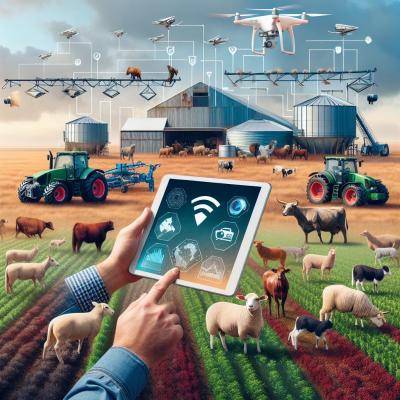Understanding the importance of safeguarding your farm's future
Estate planning involves much more than drafting a will. It's about creating a roadmap for your farm’s future beyond your tenure. The land you nurture and the business you build are more than your livelihood—they are a legacy that carries your family’s name and values, necessitating thoughtful protection and transition planning.
How farm insurance complements estate planning
Insurance is the shield that protects your estate from the unpredictable. It’s the assurance that your plans will stand firm against the storms of life's uncertainties. By integrating insurance into your estate planning, you're not just protecting your assets, but providing a buffer that safeguards your vision for your farm’s future.
Understanding the Basics of Farm Insurance
Overview of traditional farm insurance policies
Navigating the world of farm insurance can be as complex as farming itself. Traditional farm insurance policies are designed to address the unique combination of risks faced by the agricultural sector. These policies may cover everything from crops and livestock to the farmer's residence and outbuildings. Understanding the offering of each policy is the first step in cultivating a resilient farming enterprise.
What does farm insurance typically cover?
At its core, farm insurance is about safeguarding the various elements that comprise your farm. This often includes protection against natural disasters for crops, livestock insurance against disease and accidents, and property insurance for machinery and buildings. Some policies may also cover liability issues, protecting the farm owner against claims from injuries or damage to third parties occurring on the property.
The importance of assessing farm insurance needs
As no two farms are identical, neither are their insurance requirements. It’s crucial for a tech-savvy Australian farmer to regularly assess their farm's particular needs, taking stock of assets, anticipated risks, and the potential impact of losing key components of their operation. Tailoring an insurance plan to fit these considerations ensures that coverage remains relevant, providing peace of mind in an industry where so much is left to the whims of nature and the markets.
The Tech-Savvy Farm - New Risks and Liabilities
How technology has changed the farming landscape
The face of agriculture has been significantly transformed by technological innovations. Modern Australian farms are increasingly incorporating tech solutions such as automated irrigation systems, drones for surveillance and mapping, precision farming using GPS technology, and even robotics for tasks like harvesting and weeding. These advances boost efficiency and yield, but they also bring a new set of considerations for the tech-savvy farmer.
New types of risks associated with technological advancements
While these technologies are invaluable for enhancing production and management, they also introduce new risks. Sophisticated equipment and systems can be susceptible to malfunctions, cyber-attacks, or unexpected downtime, all of which can have severe consequences on farm operations. The reliance on technology means a simple software glitch can result in significant losses, highlighting the need for insurance products that cater to these modern challenges.
The need for specialized insurance to cover these new risks
Therefore, it's crucial for farmers to equip themselves with insurance that evolves alongside their technological investments. Specialized insurance plans that cover electronic equipment, data breaches, and business interruption are becoming essential. As farm machinery and data systems become more interconnected, the potential for cascading failures increases, making comprehensive and up-to-date coverage more important than ever for future-proofing the farm against these new-age liabilities.
Key Considerations for Future-Proofing Your Farm with Insurance
Assessing and Managing the Risk of Natural Disasters
For Australian farmers, confronting the reality of natural disasters—from droughts and bushfires to floods—is a critical part of risk management. Assessing these risks involves considering the frequency and severity of natural events in your area, as well as the potential impact on your operations. As climate patterns shift, staying ahead with comprehensive insurance that covers catastrophic natural disasters becomes indispensable. Ensuring that your coverage reflects the increased risk is essential for the longevity of your farm.
Insurance Protection for Smart Farm Equipment and IoT Devices
Incorporating smart technologies into farming practices is a leap forward but also requires farmers to consider the associated risks. Equipment and Internet of Things (IoT) devices are significant investments that need tailored insurance coverage. Protections against theft, damage, and operational failure of such devices can alleviate financial burdens and keep technological advancements at the forefront of your farming strategy without reservation.
The Role of Cybersecurity in the Farming Industry
The integration of technology into modern farming practices has made cybersecurity a critical issue. With farm operations increasingly reliant on digital networks and data, securing these assets against cyber threats is as important as safeguarding physical resources. Thus, farmers must explore insurance options that include cybersecurity protection to cover potential data breaches, which can lead to disrupted operations and financial loss. An ounce of prevention in the form of robust cybersecurity measures can save a pound of cure when it comes to potential insurance claims.
Innovative Insurance Products: Drone Coverage, Precision Farming, etc.
The agricultural insurance landscape is evolving with the introduction of innovative products tailored to new technologies, such as drones and precision farming tools. These insurance products are designed to address the unique risks and liabilities associated with their use. Coverage for drones, for instance, may include damage or loss during operation, while precision farming insurance might protect against technology-specific failures that impact yield. As farming technology advances, these specialized insurance products become integral to the modern farmer's risk management toolkit.
Shopping for Farm Insurance - What to Look For
Essential factors when comparing insurance options
When it comes to shopping for farm insurance, there's more to consider than just the premium costs. For the prudent farmer, it's vital to weigh a matrix of factors before selecting a policy. These include the scope of coverage, exclusivity to certain farm activities or assets, provider reputation, and the responsiveness of customer support in the event of a claim. Comparing policies side-by-side allows you to identify which insurer understands the unique nuances of your farm's operations and risks.
The balance between comprehensive coverage and cost-effectiveness
Finding the right balance between a comprehensive coverage plan and its cost-effectiveness is akin to striking gold in the farming community. It is crucial to understand that the cheapest policy isn't always the best. Instead, focus on finding a policy that offers essential coverage without compromising on key areas that could lead to significant financial loss. A tailored policy that specifically aligns with the scale and type of your operations, as well as your farm's location, can prove to be a more economically prudent choice in the long run.
Understanding the fine print: exclusions, limitations, and endorsements
One of the most overlooked aspects of choosing a farm insurance policy is the fine print—where exclusions, limitations, and endorsements reside. It's imperative to understand what's not covered under your policy or what specific conditions could void a claim. Knowing the limits of your insurance can save you from unexpected gaps in coverage. Additionally, endorsements can be added to tailor a standard policy to fit your farm's unique needs, providing an extra layer of protection where it’s most needed. Always discuss with your insurer or insurance agent to clarify these points and ensure that there are no unwelcome surprises in the event of a claim.
Case Studies: Tech-Savvy Farms That Got It Right
Real-life examples of well-insured tech-savvy farms
Understanding the merits of comprehensive farm insurance becomes clearer through real-life examples. Take the case of a Victorian family-run orchard that embraced drone technology for crop monitoring. Their foresight in obtaining specific drone insurance coverage paid off when an unexpected system failure led to the loss of a drone, which was swiftly replaced without crippling their operation financially.
Another example is a Queensland cattle station that integrated smart animal health monitoring devices throughout their herds. After a lightning strike disrupted their system, causing data loss and equipment damage, their tailored policy covered not only the physical repairs but also the business interruption costs, allowing them to maintain their cattle operations without substantial losses.
How the right insurance has saved these farms in crisis situations
For farms investing in advanced technologies, the right insurance plays a pivotal role in risk management. A New South Wales hydroponics farm discovered this when a severe storm damaged their climate-controlled greenhouses. Fortunately, their insurance policy was updated to reflect their technological upgrades, ensuring a quick recovery and minimal disruption to their crop cycles.
Similarly, a Western Australia precision-agriculture grain farm benefited from their foresight in insurance coverage when their soil sensors and automated irrigation infrastructure were damaged in a fire. Their coverage not only addressed the repair costs but also offered compensation for the potential yield loss due to the interruption in their planting season.
Lessons learned from farms that were under or over-insured
Contrasting these successes, there have been cases where farms were not adequately insured, which led to considerable financial strain. A Tasmanian berry farm failed to update their policy to include their new digital inventory and sales system, which was a costly oversight when a cyber-attack resulted in significant data loss and business downtime.
On the flip side, an over-insured South Australian viticulture enterprise realized they were paying for coverage that far exceeded their actual needs after conducting a thorough insurance review with a specialized agent. This led to adjusted premiums that better reflected their operational scale and risk, optimizing their insurance spend and redirecting funds into beneficial technology upgrades.
Navigating Insurance Claims: A Step-by-Step Guide
The process of filing an insurance claim
Dealing with the aftermath of an unexpected event on your farm can be distressing. Knowing the process of filing an insurance claim can make this trying time more manageable. Firstly, promptly notify your insurance company about the incident. Be prepared with details of the damage incurred and any immediate measures you've taken to mitigate further loss. Your insurer will guide you through their claims process, which usually includes submitting a 'Proof of Loss' form detailing the damages and associated costs.
Tips on documenting damage and losses for an insurance claim
Thorough documentation is key to a successful insurance claim. Start by taking clear photographs or videos of all damages as soon as it's safe to do so. Keep an inventory list of damaged or lost items, including their age, value, and any receipts or proof of purchase if available. This evidence provides the insurer a tangible basis for assessing your claim. Proper record-keeping also includes logging any communication with the insurer, as well as tracking expenses incurred due to the loss, such as temporary repairs or replacement costs.
How to work with an insurance adjuster
After filing a claim, an insurance adjuster will be assigned to evaluate the extent of damage and estimate the cost of repairs or replacement. It's essential to be cooperative and provide any additional information they request. However, also be assertive; ensure you are providing a comprehensive review of all damages. Don't hesitate to ask questions and seek clarifications about their findings or the next steps. Remember, the adjuster plays a crucial role, and fostering a professional and transparent relationship with them can be crucial to the outcome of your claim.
The Future of Farm Insurance: Trends to Watch
Emerging risks and how insurance products are evolving
The landscape of farming risks is in constant flux, with climate change and technological advancements at the forefront of emerging challenges. Insurers are responding by developing new products that address these evolving risks. For instance, coverage for extreme weather events is becoming more sophisticated, incorporating climate change projections into risk assessments. Insurance products are also expanding to include protections against emerging tech risks, such as drone malfunctions or the failure of automated systems, ensuring that farms remain resilient in the face of modern threats.
The rise of insurtech and its potential for customizing farm policies
Innovations in insurance technology, or 'insurtech', are revolutionizing how farm insurance policies are crafted and serviced. The rise of insurtech has led to more customizable policies, giving farmers the ability to adjust their coverage in real-time, based on seasonality, crop cycles, and even market demands. With digital platforms and apps, farmers can now manage their policies with greater ease, report claims quickly, and even integrate data from their farm's tech systems to directly influence their insurance coverage and premiums.
Predictive analytics and its impact on farm insurance rates
Predictive analytics is another area where technology is significantly impacting farm insurance. By analyzing vast datasets on weather patterns, crop yields, and farm operations, insurers can more accurately assess risk and set premiums. For farmers, this means insurance rates that more closely reflect their operation's actual risk profile, potentially leading to reduced costs for those who implement risk-reducing technologies and practices. Moreover, the use of predictive analytics can help farmers and insurers anticipate and prepare for potential losses, enhancing the resilience of the agricultural sector as a whole.
Conclusion: Investing in Your Farm’s Legacy
We've explored the various facets of insuring and future-proofing your farming enterprise, from understanding the basics of estate planning to embracing cutting-edge insurtech. As we've seen, the right insurance is a vital component in safeguarding your agricultural legacy against the myriad of risks present in an industry that is as old as civilization, yet at the forefront of technological innovation.
Recapping the importance of future-proofing your farm with the right insurance
As you forge ahead in the ever-evolving landscape of Australian farming, remember that insurance isn’t just a safety net — it's an investment in your farm's longevity. By diligently assessing your needs and staying updated with the latest in insurance products, you are ensuring that your farm can weather any storm and continue to thrive for generations to come.
Embrace technology and the necessary insurance to go with it
Technology has the power to transform your farm's productivity and sustainability, but it also brings new risks that need to be managed. I encourage you to lean into these technological advancements; invest in the smart equipment, the IoT devices, and precision agriculture tools — but do so backed by the insurance solutions that protect these investments. It is this synergy of progress and protection that will drive the future success of your farming operations.
Final thoughts on staying informed and prepared in an ever-changing industry
The farming industry's only constant is change. Staying informed about emerging risks, innovative insurance solutions, and best practices in risk management will place you at the helm, ready to steer your farm's future. Engage with farming communities, experts, and insurance professionals who can provide fresh insights and help you make informed decisions about your estate planning and risk management strategies. With a proactive mindset and the right tools at your disposal, your farm's legacy will endure, proving resilient in the face of an ever-changing world.
Last updated: Wednesday 17th January, 2024









